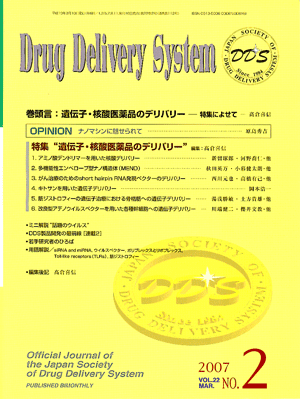All issues

Volume 22 (2007)
- Issue 6 Pages 620-
- Issue 5 Pages 510-
- Issue 4 Pages 424-
- Issue 2 Pages 108-
- Issue 1 Pages 28-
Volume 22, Issue 2
Displaying 1-6 of 6 articles from this issue
- |<
- <
- 1
- >
- >|
-
Takuro Niidome, Takahito Kawano, Masato Yamagata, Ryohsuke Kurihara, T ...2007Volume 22Issue 2 Pages 108-114
Published: 2007
Released on J-STAGE: June 07, 2007
JOURNAL FREE ACCESSDendrimer composed of L-lysines as a branch unit, dendritic poly(L-lysine), formed neutral complex with plasmid DNA, and showed high transfection efficiency without cytotoxity in vitro. Compared with linear type poly(L-lysine), uptake of the complex was lower, however, amount of transferred DNA to cytosol was larger. As compaction level of the DNA was lower, it is reasonably supposed that the high transfection efficiency of dendritic poly(L-lysine) was due to easy release of free DNA from the complex and easy access of transcription factors to the DNA.
After intravenously injection, intact DNA was observed in the blood, liver and lung even at 3 hours. Furthermore, we succeeded to deliver siRNA using dendritic poly(L-lysine) to the liver, and inhibitory effect of target gene expression could be detected. Dendritic poly(L-lysine) is expected to be used as a siRNA carrier that works in vivo.View full abstractDownload PDF (823K) -
Hidetaka Akita, Kentaro Kogure, Hideyoshi Harashima2007Volume 22Issue 2 Pages 115-122
Published: 2007
Released on J-STAGE: June 07, 2007
JOURNAL FREE ACCESSFor the development of efficient gene vector, intracellular barriers such as cellular membrane and nuclear membrane must be overcome. To regulate the intracellular trafficking, we have developed a multifunctional envelope-type nano device (MEND), which is useful for the in vivo application.View full abstractDownload PDF (1053K) -
Makiya Nishikawa, Yuki Takahashi, Yoshinobu Takakura2007Volume 22Issue 2 Pages 123-130
Published: 2007
Released on J-STAGE: June 07, 2007
JOURNAL FREE ACCESSCancer is linked to abbarent gene expression, so that its correction can be an effective approach to treating cancer patients. Silencing oncogenes or other genes contributing to tumor progression or metastasis will provide a cancer-specific therapy with minimal side effects.
RNA interference has realized the silencing of target mRNA expression in a sequence-specific manner. Both small interfering RNA (siRNA) and vectors expressing short hairpin RNA (shRNA) have been reported to be effective in silencing the genes of interest once they enter target cells. Plasmid DNA expressing shRNA (pshRNA) inhibits the expression of target genes for a longer period of time than siRNA. Because gene expression can be silenced only in cells reached by pshRNA, its delivery to tumor cells is an important factor determining its efficacy on cancer therapy.
Here we review several approaches to delivering pshRNA to tumor cells for cancer therapy.View full abstractDownload PDF (941K) -
Hirokazu Okamoto2007Volume 22Issue 2 Pages 131-139
Published: 2007
Released on J-STAGE: June 07, 2007
JOURNAL FREE ACCESSChitosan is a biocompatible compound and its complex with gene is stable against DNase. The efficiency of gene delivery with chitosan is determined by degree of deacetylation (DDA), molecular weight, and N/P ratio (the ratio of number of nitrogen in chitosan against that of phosphate in gene).
By decreasing the molecular weight of chitosan, the gene-binding ability decreases; however, aqueous solubility increases. The increase in DDA enhances the gene-binding ability of chitosan. However, too high binding ability results in decreased release of gene and gene expression in a cell. Recently many derivatives of chitosan have been reported to improve aqueous solubility or to deliver gene to a specific organ.View full abstractDownload PDF (764K) -
Katsutoshi Yuasa, Takao Hijikata, Shin'ichi Takeda2007Volume 22Issue 2 Pages 140-147
Published: 2007
Released on J-STAGE: June 07, 2007
JOURNAL FREE ACCESSMuscular dystrophies are progressive muscle-wasting diseases often caused by defects of genes encoding sarcolemmal or sarcolemma-associated proteins and their consequential deficiency in muscle. For the muscular dystrophies, gene therapy has been widely studied, and several strategies involving the use of viral vector-mediated delivery have been developed to restore partial expression of deficient proteins. However, systemic, specific and safe delivery of therapeutic genes to skeletal muscles remains major hurdles for the clinical application of those strategies.
In this review, we first introduce genetic backgrounds and pathogenesis of muscular dystrophies and then some strategies of gene therapy, undertaken for potential treatment of muscular dystrophies. Furthermore, we describe and discuss current chemical and biological methods to carry therapeutic materials including oligonucleotides and cDNAs into individual muscle fibers and to deliver them to the musculature of the whole body.View full abstractDownload PDF (791K) -
Kenji Kawabata, Fuminori Sakurai, Hiroyuki Mizuguchi2007Volume 22Issue 2 Pages 148-154
Published: 2007
Released on J-STAGE: June 07, 2007
JOURNAL FREE ACCESSThe application of adenovirus (Ad) vectors, which are widely used in gene therapy, depends on CAR (coxsackievirus and adenovirus receptor) expression on the cells. To overcome this problem, the capsid proteins of Ad vectors have been genetically modified. Here, we introduce several types of capsid-modified Ad vectors. Furthermore, we describe the application of capsid-modified Ad vectors into some kinds of stem cells for regenerative medicine.View full abstractDownload PDF (791K)
- |<
- <
- 1
- >
- >|